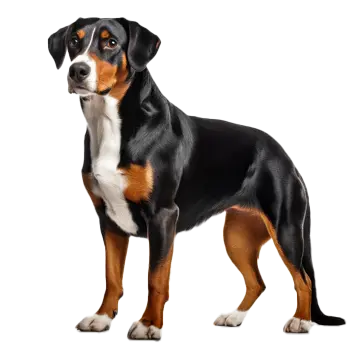The Appenzeller Sennenhund is generally considered a healthy and robust breed with relatively few inherited health problems compared to many other purebred dogs. This hardiness likely stems from the breed's working heritage and the fact that breeding has historically emphasized function and working ability over appearance alone. Most Appenzellers enjoy active lives well into their senior years, with an average lifespan of 12 to 14 years, which is quite good for a medium-sized breed. Some individuals have been known to live even longer when provided with proper care, nutrition, and regular veterinary attention.
Despite their overall good health, Appenzellers can be affected by certain genetic conditions that potential owners should be aware of. Hip dysplasia is one concern that appears in the breed, though not as commonly as in some other medium to large dog breeds. This orthopedic condition involves malformation of the hip joint where the ball and socket do not fit together properly, leading to joint instability, pain, and potentially arthritis over time. Responsible breeders screen their breeding stock through organizations like the Orthopedic Foundation for Animals to help reduce the incidence of hip dysplasia in their lines. Elbow dysplasia, another developmental joint condition, can also occur in Appenzellers, though it appears less frequently than hip dysplasia.
Progressive retinal atrophy, or PRA, represents another health consideration for the breed. This inherited eye disease causes gradual deterioration of the retina, eventually leading to blindness. While not common in Appenzellers, the condition does appear occasionally in the breed. Genetic testing is available to identify carriers of PRA, allowing breeders to make informed decisions about breeding pairs and potentially eliminate this condition from their lines over time. Regular eye examinations by a board-certified veterinary ophthalmologist can detect early signs of PRA and other eye conditions.
Bloat, medically known as gastric dilatation-volvulus or GDV, is a life-threatening emergency that can affect Appenzellers and other deep-chested breeds. This condition occurs when the stomach fills with gas and potentially twists on itself, cutting off blood flow and trapping the gas inside. Bloat requires immediate emergency veterinary treatment and can be fatal without rapid intervention. Owners can take preventive measures by feeding multiple smaller meals rather than one large meal daily, avoiding vigorous exercise immediately before and after meals, and using elevated feeding bowls cautiously. Some owners of at-risk dogs choose prophylactic gastropexy surgery to prevent stomach torsion.
Cancer can affect Appenzellers as they age, though the breed does not appear to have a particularly elevated risk compared to other breeds. Various forms of cancer may occur, and early detection through regular veterinary examinations can improve treatment outcomes. Allergies, both environmental and food-related, appear occasionally in the breed and can cause skin irritation, itching, and discomfort. Identifying and managing allergens through diet changes or medical treatment helps affected dogs maintain comfortable, healthy lives.
Preventive health care plays a crucial role in keeping Appenzellers healthy throughout their lives. Regular veterinary examinations, ideally annually for young adults and semi-annually for senior dogs, allow early detection of potential health issues before they become serious problems. Vaccinations protect against common infectious diseases and should be maintained according to your veterinarian's recommendations based on your dog's lifestyle and risk factors. Parasite prevention for fleas, ticks, heartworms, and intestinal parasites is essential year-round in most areas.
Dental care significantly impacts overall health, as periodontal disease can lead to systemic infections affecting the heart, liver, and kidneys. Regular professional dental cleanings combined with home dental care help maintain oral health and prevent associated problems. Blood work screening, especially as dogs enter their senior years, can detect organ dysfunction, metabolic disorders, and other issues before clinical signs become apparent.
Weight management is crucial for Appenzellers' long-term health and mobility. Despite their high energy levels, these dogs can gain excess weight if overfed or under-exercised, particularly as they age. Obesity stresses joints, contributes to other health problems, and can shorten lifespan. Maintaining lean body condition through proper nutrition and regular exercise helps ensure Appenzellers remain active and healthy throughout their lives. A balanced, high-quality diet appropriate for the dog's age, activity level, and any specific health needs supports overall wellbeing and longevity.
Common Health Issues
- Hip dysplasia is one concern that appears in the breed, though not as commonly as in some other medium to large dog breeds.
- Responsible breeders screen their breeding stock through organizations like the Orthopedic Foundation for Animals to help reduce the incidence of hip dysplasia in their lines.
- Elbow dysplasia, another developmental joint condition, can also occur in Appenzellers, though it appears less frequently than hip dysplasia.
- Cancer can affect Appenzellers as they age, though the breed does not appear to have a particularly elevated risk compared to other breeds.
- Various forms of cancer may occur, and early detection through regular veterinary examinations can improve treatment outcomes.
- Allergies, both environmental and food-related, appear occasionally in the breed and can cause skin irritation, itching, and discomfort.
Preventive Care & Health Monitoring
- Some individuals have been known to live even longer when provided with proper care, nutrition, and regular veterinary attention.
- Owners can take preventive measures by feeding multiple smaller meals rather than one large meal daily, avoiding vigorous exercise immediately before and after meals, and using elevated feeding bowls cautiously.
- Various forms of cancer may occur, and early detection through regular veterinary examinations can improve treatment outcomes.
- Regular veterinary examinations, ideally annually for young adults and semi-annually for senior dogs, allow early detection of potential health issues before they become serious problems.
Regular veterinary check-ups and preventive care are essential for maintaining your Appenzeller Sennenhunde's health and longevity.

